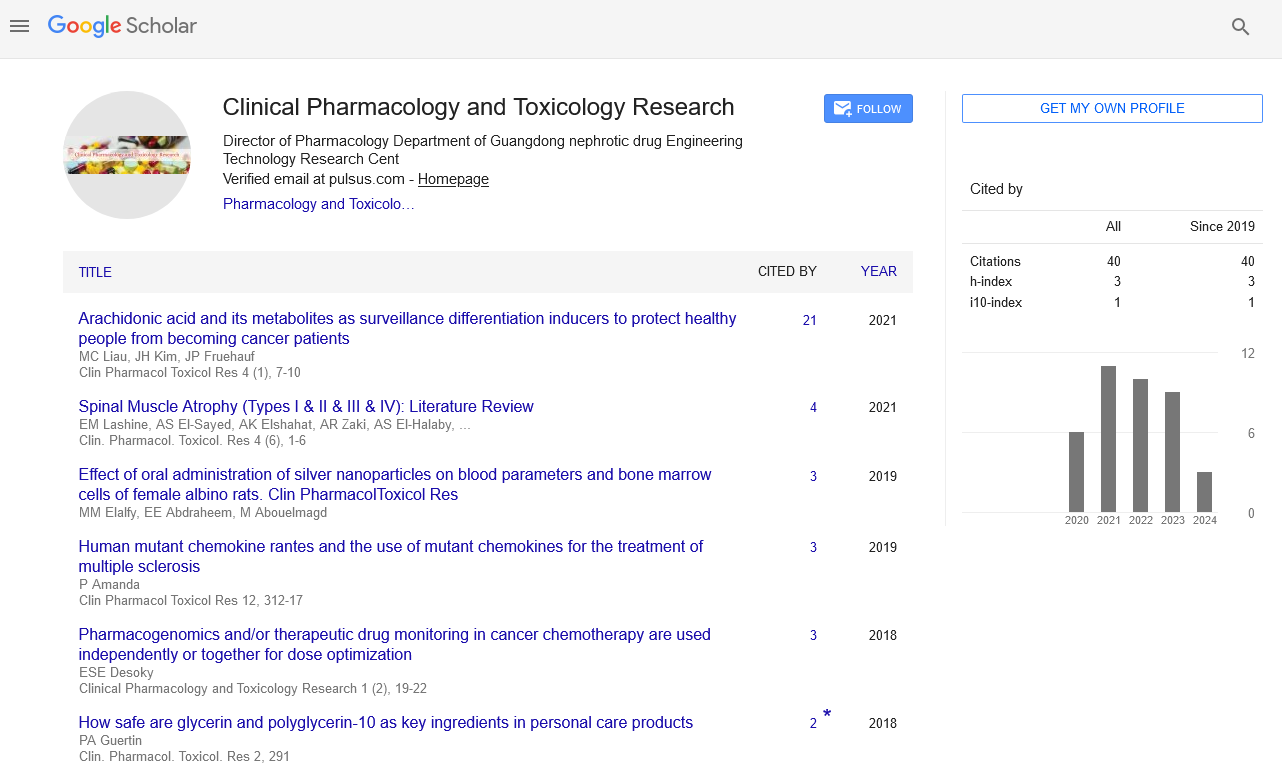Clinical Pharmacology of Covid19
Received: 09-Jul-2020 Accepted Date: Jul 16, 2020; Published: 23-Jul-2020
Citation: Zack A. Clinical Pharmacology of Covid19. Clin Pharmacol Toxicol Res. 2020;3(2):1.
This open-access article is distributed under the terms of the Creative Commons Attribution Non-Commercial License (CC BY-NC) (http://creativecommons.org/licenses/by-nc/4.0/), which permits reuse, distribution and reproduction of the article, provided that the original work is properly cited and the reuse is restricted to noncommercial purposes. For commercial reuse, contact reprints@pulsus.com
Role of Pharmacology of Covid 19
A corona virus is a common virus which causes infection in nose, sinuses and upper throat. It is related to the group of RNA viruses. It can cause common cold, Severe Acute Respiratory Syndrome (SARS) and Middle East Respiratory Syndrome (MERS). Now the virus is known as Severe Acute Respiratory Syndrome Coronavirus 2 (SARS-CoV-2) and the disease caused by it is called as Corona virus disease 2019 (COVID-19). SARS-CoV-2 is one of seven kinds of corona virus. This virus is a new one and so it does not have any medicine [1]. As the disease is increasing day by day pharmacologists were researching on the antibodies against the virus. As the virus is new pharmacologists cannot able to find the trigger point of the virus. Corona virus not only causes flu like other viruses but also it causes severe illness leading to death even.
Diseases like chronic kidney disease, Chronic Obstructive Pulmonary Disease (COPD), obesity, heart failure, coronary artery disease, sickle cell disease, asthma, cystic fibrosis, dementia, thalassemia, high blood pressure, smoking, liver disease, type 1 and type 2diabetes can increase the severity of the illness. Symptoms of corona virus may include fever, cough, runny nose, shortness of breath, headache, muscle aches, sore throat, loss of smell and taste, nausea, diarrhea, body ache, chest pain and fatigue [2]. This virus spreads through droplets released by a person affected with cough or cold. When the infected person coughs or sneeze, the droplets spread into air and travels up to 6 feet away. The virus infects different in each person based on the immunity. A person with increased immunity can be less affected by corona virus.
Hydroxychloroquine is a derivative of chloroquine which has antimalarial and anti-inflammatory actions. It may suppress the immune function by interfering with the processing of antigens and the production of cytokines. It also raises intra lysosomal pH, impairing autophagic protein degradation and cell death in tumor cells reliant on autophagy for survival. Hydroxychloroquine also acts as an immune suppressant inhibiting the production of rheumatoid factor. Hydroxychloroquine also reduces the release of cytokines like interleukin-1 and tumor necrosis factor through inhibition of Toll-like receptors. Hydroxychloroquine can also interfere with the action of parasitic heme polymerase allowing it for the accumulation of the toxic product beta-hematin [3]. The accumulation of hydroxychloroquine in human organelles also raises their pH which inhibits antigen processing, prevents the alpha and beta chains of the major histocompatibility complex (MHC) class 2 from dimerizing, inhibits antigen presentation of the cell and reduces the inflammatory response. Increased pH levels in the vesicles may alter the recycling of major histocompatibility complexes. So, the high affinity complexes are presented on the cell surface. Self-peptides bind to MHC complex with low affinity. So, they will be less likely to be presented to autoimmune T cells. The raised pH in the endosomes prevents viruses from using their activity for fusion and entry into the cell. Hydroxychloroquine inhibits terminal glycosylation of ACE2 which is a receptor that SARS-CoV and SARS-CoV-2 target for cell entry. ACE2 which is not present in the glycosylated state may less effectively interact with the SARS-COV-2 spike protein to further inhibit viral entry [4].
Hydroxychloroquine (Plaquenil) is considered a disease-modifying antirheumatic drug (DMARD). It can decrease the pain and swelling of arthritis. It may prevent joint damage and reduce the risk of long-term disability. Hydroxychloroquine is in a class of medications that was first used to prevent and treat malaria. Today, it is used to treat rheumatoid arthritis, some symptoms of lupus, childhood arthritis (or juvenile idiopathic arthritis) and other autoimmune diseases. It is not clear why hydroxychloroquine is effective at treating autoimmune diseases [5].
Hydroxychloroquine is a 4-aminoquinoline with immunosuppressive, antiautophagy, and antimalarial activities. Although the precise mechanism of action is unknown, hydroxychloroquine may suppress immune function by interfering with the processing and presentation of antigens and the production of cytokines.
Hydroxychloroquine has 67-74% bioavailability. The percent of renal excretion of hydroxychloroquine is 40-50% and only 16-21% of the dose is excreted through urine as unchanged drug. 5% of drug id eliminated through skin and 24-25% is excreted through faeces. Hydroxychloroquine has a volume of distribution of 5522 L in blood and 44,257 L from plasma. The clearance of hydroxychloroquine is 96 ml/min. Oral hydroxychloroquine has an absorption half-life of 3-4 hours.
REFERENCES
- Amanda P. Human mutant chemokine rantes and the use of mutant chemokines for the treatment of multiple sclerosis. Clin Pharmacol Toxicol Res. 2019;12:312-17.
- Moskalev AV. The role of chemokines in the development of an antiviral immune response Clin Pharmacol Toxicol Res. 2017;3:183-88.
- Esche C, Stellato C,BeckLA. Chemokines: Keyplayers in innate and adaptive immunity. Clin Pharmacol Toxicol Res. 2018;125:615-28.
- LoetscherP, Seitz M, Clark-Lewis I,et al. Activation ofNKcells by CC chemokines. Chemotaxis, Ca2+ mobilization, and enzyme release. Clin Pharmacol Toxicol Res. 2017;156:322-27
- Sallusto F, Mackay CR, Lanzavecchia A. The role of chemokine receptors in primary, effector, and memory immune responses. Annu Rev Immunol. 2000;18:593-620.





